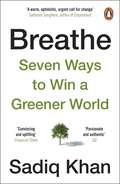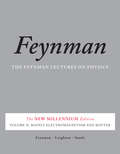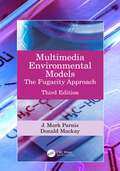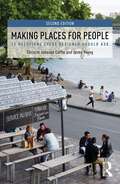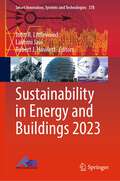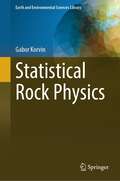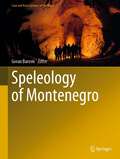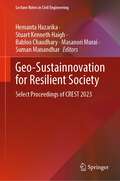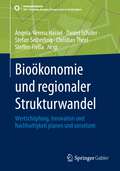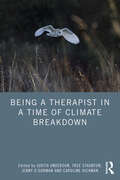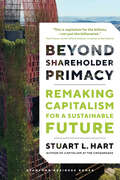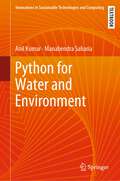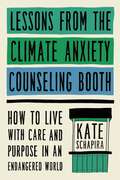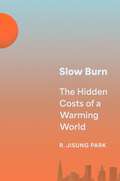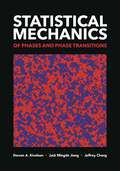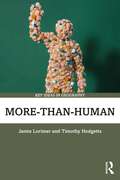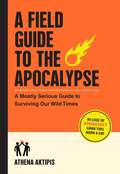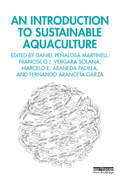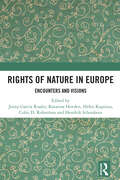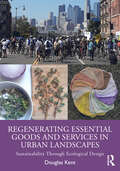- Table View
- List View
Breathe: Seven Ways to Win a Greener World
by Sadiq Khan'A breath of fresh air' Observer'Passionate and authentic' GQ'Refreshing and galvanising' Vogue'Rousing and thoughtful' Independent'Quite the page-turner' Evening StandardTo win the climate war, you first need to win the climate argument.For many years, Sadiq wasn't fully aware of the dangers posed by air pollution, nor its connection with climate change. Then, aged 43, he was unexpectedly diagnosed with adult-onset asthma - brought on by the polluted London air he had been breathing for decades.Scandalised, Sadiq underwent a political transformation that would see him become one of the most prominent global politicians fighting (and winning) elections on green issues. Since becoming Mayor of London in 2016, he has declared a climate emergency, introduced the world's first Ultra-Low Emission Zone, and turned London into the first-ever 'National Park City'.Now, Sadiq draws on his experiences to reveal the seven ways environmental action gets blown off course - and how to get it back on track. Whether by building coalitions across the political spectrum, putting social justice at the heart of green politics, or showing that the climate crisis is a health crisis too, he offers a playbook for anyone - voter, activist or politician - who wants to win the argument on the environment.It will help create a world where we can all breathe again.
The Feynman Lectures on Physics, Vol. II: The New Millennium Edition: Mainly Electromagnetism and Matter
by Richard P. Feynman Robert B. Leighton Matthew Sands"The whole thing was basically an experiment," Richard Feynman said late in his career, looking back on the origins of his lectures. The experiment turned out to be hugely successful, spawning publications that have remained definitive and introductory to physics for decades. Ranging from the basic principles of Newtonian physics through such formidable theories as general relativity and quantum mechanics, Feynman's lectures stand as a monument of clear exposition and deep insight.Timeless and collectible, the lectures are essential reading, not just for students of physics but for anyone seeking an introduction to the field from the inimitable Feynman.
Multimedia Environmental Models: The Fugacity Approach
by J. Mark Parnis Donald MackayMultimedia Environmental Models: The Fugacity Approach, Third Edition, takes a broad approach of viewing chemical behavior in the total biosphere of connected biotic and abiotic compartments. Chemicals are subject to the laws of "mass balance," a constraint that provides the opportunity to establish quantitative expressions for chemical fate that are central to chemical management and regulatory legislation. This book employs both the conventional concentration-based procedures and those based on application of the more elegant and powerful concept of fugacity to characterize equilibrium, steady-state distribution, and time-dependent transport between environmental phases such as air, water, and soil. Organic chemicals are emphasized because they are more easily generalized when assessing environmental behavior.Features Illustrates professional approaches to calculating the fate of chemicals in the environment Explicitly details all worked examples in an annotated step-by-step fashion Presents real-life freely downloadable models of use to government, industry, and private consulting professionals and students alike Clarifies symbols and notation
Making Places for People: 12 Questions Every Designer Should Ask
by Christie Johnson Coffin Jenny YoungMaking Places for People explores 12 social questions crucial to environmental design. Authors Christie Johnson Coffin and Jenny Young bring perspectives from practice and teaching to challenge assumptions about how places meet human needs. In this expanded second edition, the authors continue to explore the complexities of basic questions, such as: What is the story of this place? What logic orders it? How big is it? How sustainable is it? They consider the impact on making places of pandemic, climate change, human migration, and contemporary discussions of diversity, equity, and justice. Short, approachable, easy-to-read chapters, illustrated with updated examples of projects from around the world, bring together theory, methodology and key research findings. Understanding experienced and research-based connections between people and built form can inspire designs that make places of meaning and delight. This second edition will be essential reading for design students and professionals.
Sustainability in Energy and Buildings 2023 (Smart Innovation, Systems and Technologies #378)
by John R. Littlewood Lakhmi Jain Robert J. HowlettThis book contains the proceedings of the 15th KES International Conference on Sustainability and Energy in Buildings 2023 (SEB2023) held in Bari, Italy, during September 18–20, 2023, organized by KES International. SEB23 invited contributions on a range of topics related to sustainable buildings and explored innovative themes regarding sustainable energy systems. The conference formed an exciting chance to present, interact, and learn about the latest research and practical developments on the subject. The conference attracted submissions from around the world. Submissions for the full-paper track were subjected to a blind peer-reviewed process. Only the best of these were selected for presentation at the conference and publication in these proceedings. It is intended that this book provides a useful and informative snapshot of recent research developments in the important and vibrant area of sustainability in energy and buildings.
Statistical Rock Physics (Earth and Environmental Sciences Library)
by Gabor KorvinThe book is the first systematic and comprehensive treatise of stochastic models and computational tools that have emerged in rock-physics in the last 20 years. The field of statistical rock-physics is a part of rock-physics (Petrophysics). Its concepts, methods and techniques are borrowed from stochastic geometry and statistical physics. This discipline describes the interior geometry of rocks; derives their effective physical properties based on their random composition and the random arrangement of their constituents; and builds models to simulate the past geological processes that had formed the rock. The aim of the book is to help the readers to understand the claims, techniques and published results of this new field and—most importantly—to teach them in order to creatively apply stochastic geometry and statistical physics in their own research tasks. For this purpose, the underlying mathematics will be discussed in all sections of the book; numerical solutions will be highlighted; a full set of references will be provided; and theory will go hand-in-hand with practical applications to hydraulic permeability, electric conduction, rock failure, NMR, mechanics of random grain packings, as well as the compaction of shale.
Speleology of Montenegro (Cave and Karst Systems of the World)
by Goran BarovicThis book represents a comprehensive overview of the caves and karsts of Montenegro, a small territory yet one of the fascinating areas regarding speleology. In Montenegro, there are more than 1500 karst wonders identified. Đalovića cave, with more than 20 km, ranks as the longest in the region. In the Maganika massif, Iron Cave also ranks first but because of its length reaching 1100 m. Montenegro's history is also connected to caves as two very popular and visited sanctuaries, monasteries built in the cave - Ostrog and Dajbabe. In another speleo-archaeological site, cave Red Rock, 32 layers with a measured age of 180,000 years, is highly relevant in Europe.
Geo-Sustainnovation for Resilient Society: Select Proceedings of CREST 2023 (Lecture Notes in Civil Engineering #446)
by Hemanta Hazarika Stuart Kenneth Haigh Babloo Chaudhary Masanori Murai Suman ManandharThis book presents select proceedings of the 2nd International Conference on Construction Resources for Environmentally Sustainable Technologies (CREST 2023), and focuses on sustainability, promotion of new ideas and innovations in design, construction and maintenance of geotechnical structures with the aim of contributing towards climate change adaptation and disaster resiliency to meet the UN Sustainable Development Goals (SDGs). It presents latest research, information, technological advancement, practical challenges encountered, and solutions adopted in the field of geotechnical engineering for sustainable infrastructure towards climate change adaptation. This volume will be of interest to those in academia and industry alike.
Bioökonomie und regionaler Strukturwandel: Wertschöpfung, Innovation und Nachhaltigkeit planen und umsetzen (SDG - Forschung, Konzepte, Lösungsansätze zur Nachhaltigkeit)
by Angela-Verena Hassel Daniel Schiller Stefan Seiberling Christian Theel Steffen FleßaBioökonomie ist eine neue branchenübergreifende Form des Wirtschaftens, die das Potenzial hat, die bisherige Ökonomie und einzelne Regionen grundlegend zu verändern. Dieser Überzeugung folgend stellen die Herausgeber und Autoren dieses Buches den aktuellen Wissenstand aus Theorie und Praxis der Bioökonomie zusammen, entwickeln neue Methoden für einen bioökonomischen Strukturwandel und reflektieren bestehende Bioökonomiekonzepte. Der komplexe und vielschichtige Prozess einer pflanzenbasierten Bioökonomie in ländlichen Räumen wird aus unterschiedlichen Perspektiven betrachtet. Zunächst werden ökonomische Grundlagen sowohl aus gesamt- als auch aus einzelwirtschaftlicher Sicht diskutiert. Dem schließen sich Beispiele an, wie regionale Innovationsnetzwerke und Wertschöpfungsketten der Bioökonomie einen Beitrag zur nachhaltigen Regionalentwicklung und zum gesellschaftlichen Wandel leisten können. Die darauf aufbauende Analyse legt dar, wie verschiedene Akteure und Prozesse eine regionale Bioökonomie in der Praxis etablieren können. Ausgewählte Anwendungs- und Umsetzungsbeispiele für Innovationen pflanzenbasierter Bioökonomie im nordöstlichen Mecklenburg-Vorpommern runden das Buch ab und zeigen das Potenzial für eine Transformation der Wirtschaft in der Region und darüber hinaus.
Being a Therapist in a Time of Climate Breakdown
by Judith Anderson Tree Staunton Jenny O’Gorman Caroline HickmanThis book introduces readers to the known psychological aspects of climate change as a pressing global concern and explores how they are relevant to current and future clinical practice.Arguing that it is vital for ecological concerns to enter the therapy room, this book calls for change from regulatory bodies, training institutes and individual practitioners. The book includes original thinking and research by practitioners from a range of perspectives, including psychodynamic, eco-systemic and integrative. It considers how our different modalities and ways of working need to be adapted to be applicable to the ecological crises. It includes Voices from people who are not practitioners about their experience including how they see the role of therapy. Chapters deal with topics from climate science, including the emotional and mental health impacts of climate breakdown, professional ethics and wider systemic understandings of current therapeutic approaches. Also discussed are the practice-based implications of becoming a climate-aware therapist, eco-psychosocial approaches and the inextricable links between the climate crises and racism, colonialism and social injustice. Being a Therapist in a Time of Climate Breakdown will enable therapists and mental health professionals across a range of modalities to engage with their own thoughts and feelings about climate breakdown and consider how it both changes and reinforces aspects of their therapeutic work.
Being a Therapist in a Time of Climate Breakdown
This book introduces readers to the known psychological aspects of climate change as a pressing global concern and explores how they are relevant to current and future clinical practice.Arguing that it is vital for ecological concerns to enter the therapy room, this book calls for change from regulatory bodies, training institutes and individual practitioners. The book includes original thinking and research by practitioners from a range of perspectives, including psychodynamic, eco-systemic and integrative. It considers how our different modalities and ways of working need to be adapted to be applicable to the ecological crises. It includes Voices from people who are not practitioners about their experience including how they see the role of therapy. Chapters deal with topics from climate science, including the emotional and mental health impacts of climate breakdown, professional ethics and wider systemic understandings of current therapeutic approaches. Also discussed are the practice-based implications of becoming a climate-aware therapist, eco-psychosocial approaches and the inextricable links between the climate crises and racism, colonialism and social injustice. Being a Therapist in a Time of Climate Breakdown will enable therapists and mental health professionals across a range of modalities to engage with their own thoughts and feelings about climate breakdown and consider how it both changes and reinforces aspects of their therapeutic work.
Beyond Shareholder Primacy: Remaking Capitalism for a Sustainable Future
by Stuart HartFrom the author of Capitalism at the Crossroads, a call to consciousness—and action—for individuals, organizations, communities, and nations. Our current Milton Friedman–style "shareholder primacy capitalism," as taught in business schools and embraced around the world, has become dangerous for society, the climate, and the planet. Moreover, Stuart L. Hart argues, it's economically unnecessary. But there are surprising reasons for hope—from the history of capitalism itself. Beyond Shareholder Primacy argues that capitalism has reformed itself twice before and is poised for a third major reformation. Retelling the origin story of capitalism from the fifteenth century to the present, Hart argues that a radically sustainable, just capitalism is possible, and even likely, in our lifetime. Hart goes on to describe what it will take to move beyond capitalism's present worship of "shareholder primacy," including corporate transformations to re-embed purpose and reforms to major economic institutions. A key requirement is eliminating the "externalities" (or collateral damage) of our current shareholder capitalism. Sustainable capitalism will explicitly incorporate the needs of society and the planet, include a financial system that allows leaders to prioritize the planet, reorganize business schools around sustainable management thinking, and enable corporations not just to stop ignoring the damage they cause, but actually begin to create positive impact.
Beyond Shareholder Primacy: Remaking Capitalism for a Sustainable Future
by Stuart HartFrom the author of Capitalism at the Crossroads, a call to consciousness—and action—for individuals, organizations, communities, and nations. Our current Milton Friedman–style "shareholder primacy capitalism," as taught in business schools and embraced around the world, has become dangerous for society, the climate, and the planet. Moreover, Stuart L. Hart argues, it's economically unnecessary. But there are surprising reasons for hope—from the history of capitalism itself. Beyond Shareholder Primacy argues that capitalism has reformed itself twice before and is poised for a third major reformation. Retelling the origin story of capitalism from the fifteenth century to the present, Hart argues that a radically sustainable, just capitalism is possible, and even likely, in our lifetime. Hart goes on to describe what it will take to move beyond capitalism's present worship of "shareholder primacy," including corporate transformations to re-embed purpose and reforms to major economic institutions. A key requirement is eliminating the "externalities" (or collateral damage) of our current shareholder capitalism. Sustainable capitalism will explicitly incorporate the needs of society and the planet, include a financial system that allows leaders to prioritize the planet, reorganize business schools around sustainable management thinking, and enable corporations not just to stop ignoring the damage they cause, but actually begin to create positive impact.
Python for Water and Environment (Innovations in Sustainable Technologies and Computing)
by Anil Kumar Manabendra SahariaThis textbook delves into the practical applications of surface and groundwater hydrology, as well as the environment. The Part I, "Practical Python for a Water and Environment Professional," guides readers through setting up a scientific computing environment and conducting exploratory data analysis and visualization using reproducible workflows. The Part II, "Statistical Modeling in Hydrology," covers regression models, time series analysis, and common hypothesis testing. The Part III, "Surface and Subsurface Water," illustrates the use of Python in understanding key concepts related to seepage, groundwater, and surface water flows. Lastly, the Part IV, "Environmental Applications," demonstrates the application of Python in the study of various contaminant transport phenomena.
Lessons from the Climate Anxiety Counseling Booth: How to Live with Care and Purpose in an Endangered World
by Kate SchapiraClimate anxiety is real—and this practical, accessible guide helps address it on personal, relational, and structural levels, from the founder of the Climate Anxiety Counseling Booth. Summer after summer is the hottest on record. People&’s homes are flooding, burning, blowing away. We live with the loss, pain, and grief of what&’s happened, and anxiety for what might happen next, as the systems in which we live are increasingly strained. Lessons from the Climate Anxiety Counseling Booth addresses our collective concerns with empathy, grace, and practical strategies to help us all envision a viable future. By moving through your personal and general climate anxiety, frustration, helplessness and grief, you can move toward a sense of shared purpose and community care. You&’ll find actionable steps for connecting with others, identifying and activating community abundance, matching your skills with organized climate activism, and imagining a radically more livable future in order to bring it into being. Lessons from the Climate Anxiety Counseling Booth meets you where you are, not sugarcoating the realities of this growing crisis, but offering practical strategies for meeting a climate-changed present and future with emotional honesty and communal support. In 2014, when Kate Schapira first set up a Climate Anxiety Counseling booth in her hometown of Providence, Rhode Island, far fewer people were talking about climate change and its attendant anxiety, leaving those who couldn&’t ignore climate change and the forces that cause it feeling frantic and alone. Seeking a way to reach out and connect, Schapira set up a Peanuts-style "The Doctor Is In" booth to talk about climate change with her community. Ten years and over 1200 conversations later, Schapira channels all she&’s learned into an accessible, understandable, and aware guide for processing climate anxiety and connecting with others to carry out real change in your life and in your community.
Slow Burn: The Hidden Costs of a Warming World
by Robert Jisung ParkHow the subtle but significant consequences of a hotter planet have already begun—from lower test scores to higher crime rates—and how we might tackle them todayIt&’s hard not to feel anxious about the problem of climate change, especially if we think of it as an impending planetary catastrophe. In Slow Burn, R. Jisung Park encourages us to view climate change through a different lens: one that focuses less on the possibility of mass climate extinction in a theoretical future, and more on the everyday implications of climate change here and now.Drawing on a wealth of new data and cutting-edge economics, Park shows how climate change headlines often miss some of the most important costs. When wildfires blaze, what happens to people downwind of the smoke? When natural disasters destroy buildings and bridges, what happens to educational outcomes? Park explains how climate change operates as the silent accumulation of a thousand tiny conflagrations: imperceptibly elevated health risks spread across billions of people; pennies off the dollar of productivity; fewer opportunities for upward mobility.By investigating how the physical phenomenon of climate change interacts with social and economic institutions, Park illustrates how climate change already affects everyone, and may act as an amplifier of inequality. Wealthier households and corporations may adapt quickly, but, without targeted interventions, less advantaged communities may not.Viewing climate change as a slow and unequal burn comes with an important silver lining. It puts dollars and cents behind the case for aggressive emissions cuts and helps identify concrete steps that can be taken to better manage its adverse effects. We can begin to overcome our climate anxiety, Park shows us, when we begin to tackle these problems locally.
Statistical Mechanics of Phases and Phase Transitions
by Steven A. Kivelson Jack Mingde Jiang Jeffrey ChangAn engaging undergraduate introduction to the statistical mechanics of phase transitionsStatistical mechanics deploys a powerful set of mathematical approaches for studying the thermodynamic properties of complex physical systems. This textbook introduces students to the statistical mechanics of systems undergoing changes of state, focusing on the basic principles for classifying distinct thermodynamic phases and the critical phenomena associated with transitions between them. Uniquely designed to promote active learning, Statistical Mechanics of Phases and Phase Transitions presents some of the most beautiful and profound concepts in physics, enabling students to obtain an essential understanding of a computationally challenging subject without getting lost in the details.Provides a self-contained, conceptually deep introduction to the statistical mechanics of phases and phase transitions from a modern perspectiveCarefully leads students from spontaneously broken symmetries to the universality of phase transitions and the renormalization groupEncourages student-centric active learning suitable for both the classroom and self-studyFeatures a wealth of guided worksheets with full solutions throughout the book that help students learn by doingIncludes informative appendixes that cover key mathematical concepts and methodsIdeal for undergraduate physics majors and beginning graduate studentsSolutions manual for all end-of-chapter problems (available only to instructors)
More-than-Human (ISSN)
by Jamie Lorimer Timothy HodgettsThis text offers the first book-length introduction to more-than-human geography, exploring its key ideas, main debates, and future prospects.An opening chapter traces the origins and emergence of this field of enquiry and positions more-than-human geography as a response to a set of intellectual and political crises in Western thought and politics. It identifies key literatures and thinkers and reflects on the varying usages and meanings of the idea of the more-than-human. Three subsequent sections explore cross-cutting themes that draw together the disparate strands of more-than-human geography: examining new materialisms developed in the field, analysing knowledge practices and methodologies, and finally reflecting on the political and ethical implications of a more-than-human approach. A final chapter examines the tensions between this approach and cognate work in environmental geography to review the strengths and the limitations of more-than-human geographies, and to speculate as to their near future development.Introducing the key idea of more-than-human geography, this book will be an important resource for undergraduate and postgraduate students of human geography, environmental geography, cultural and social geography, and political geography.
More-than-Human (ISSN)
by Jamie Lorimer Timothy HodgettsThis text offers the first book-length introduction to more-than-human geography, exploring its key ideas, main debates, and future prospects.An opening chapter traces the origins and emergence of this field of enquiry and positions more-than-human geography as a response to a set of intellectual and political crises in Western thought and politics. It identifies key literatures and thinkers and reflects on the varying usages and meanings of the idea of the more-than-human. Three subsequent sections explore cross-cutting themes that draw together the disparate strands of more-than-human geography: examining new materialisms developed in the field, analysing knowledge practices and methodologies, and finally reflecting on the political and ethical implications of a more-than-human approach. A final chapter examines the tensions between this approach and cognate work in environmental geography to review the strengths and the limitations of more-than-human geographies, and to speculate as to their near future development.Introducing the key idea of more-than-human geography, this book will be an important resource for undergraduate and postgraduate students of human geography, environmental geography, cultural and social geography, and political geography.
A Field Guide to the Apocalypse: A Mostly Serious Guide to Surviving Our Wild Times
by Athena AktipisA common sense field guide to understanding, surviving, and thriving in our time of complex chaos and crises. Is this finally it? The end times?Because from COVID-19 to climate catastrophe to the looming AI revolution—not to mention the ever-growing background hum of rage, fear, and anxiety—it&’s starting to feel like the party we call civilization is just about over. The good news? It&’s always felt that way. Drawing on evolutionary psychology, history, brain science, game theory, and more, cooperation theorist (and, coincidentally, zombie expert) Athena Aktipis reassuringly explains how we, as a species, are hardwired to survive big existential crises. And how we can do so again by leveraging our innate abilities to communicate and cooperate. Pack a ukulele in your prep kit. Practice your risk-management skills. Enlist your crew into a survival team. And embrace the apocalypse. You might just enjoy it. Plus, it will help us build a better and more resilient future for all humankind.
An Introduction to Sustainable Aquaculture
by Daniel Peñalosa Martinell Vergara-Solana, Francisco J Araneda Padilla, Marcelo E Fernando Aranceta GarzaThis new textbook provides an accessible introduction to sustainable aquaculture through its relationship with three key pillars: the environment, the economy, and society.As the demand for seafood keeps increasing, aquaculture is considered one of the most promising and sustainable ways to satisfy this demand with nutritious and high-quality food. It is important to understand, therefore, the wider role and impact aquaculture has on the environment, the economy, and society. The book begins by providing a foundational introduction to aquaculture and sustainability, discussing the complex and interdependent relationship that exists between the two. The core text of the book is divided into four parts which focus on the environment, economics, social impacts, and governance and technologies. Chapters examine key issues surrounding climate change, food security, new technologies, bioeconomics and risk analysis, international cooperation, employment, and animal welfare, with the book concluding with a chapter examining the future directions and challenges for the aquaculture industry. The book draws on global case studies and each chapter is accompanied by recommended reading and chapter review questions to support student learning.This book will serve as an essential guide for students of aquaculture, fisheries management, and sustainable food, as well as practitioners and policymakers engaged in sustainable fishery development.
An Introduction to Sustainable Aquaculture
by Daniel Peñalosa Martinell Francisco J. Vergara-Solana Marcelo E. Araneda Padilla Fernando Aranceta GarzaThis new textbook provides an accessible introduction to sustainable aquaculture through its relationship with three key pillars: the environment, the economy, and society.As the demand for seafood keeps increasing, aquaculture is considered one of the most promising and sustainable ways to satisfy this demand with nutritious and high-quality food. It is important to understand, therefore, the wider role and impact aquaculture has on the environment, the economy, and society. The book begins by providing a foundational introduction to aquaculture and sustainability, discussing the complex and interdependent relationship that exists between the two. The core text of the book is divided into four parts which focus on the environment, economics, social impacts, and governance and technologies. Chapters examine key issues surrounding climate change, food security, new technologies, bioeconomics and risk analysis, international cooperation, employment, and animal welfare, with the book concluding with a chapter examining the future directions and challenges for the aquaculture industry. The book draws on global case studies and each chapter is accompanied by recommended reading and chapter review questions to support student learning.This book will serve as an essential guide for students of aquaculture, fisheries management, and sustainable food, as well as practitioners and policymakers engaged in sustainable fishery development.
Rights of Nature in Europe: Encounters and Visions
by Jenny García Ruales Katarina Hovden Helen Kopnina Colin D. Robertson Hendrik SchoukensThis book addresses the recognition of the Rights of Nature (RoN) in Europe, examining their conceptualisation and implementation. RoN refers to a diverse set of legal developments that seek to redefine Nature's status within the law, gradually emerging as a novel template for environmental protection. Countries like Ecuador and New Zealand, each with distinct histories and ways of dwelling in the world, have pioneered a new era in environmental governance by legally acknowledging rights or personhood for nature, ecosystems, and more-than-human populations.In recent years, Europe has witnessed growing interest in RoN, with academic, legislative, and political initiatives gaining momentum. A significant development is the September 2022 passage of a law in the Spanish Parliament, granting legal personhood and rights to the Mar Menor, a saltwater lagoon severely affected by environmental degradation.Given the diversity in interpretations and articulations of ‘Rights of Nature’, this edited volume argues that their arrival in Europe fosters different kinds of interactions across distinct areas of law, knowledge, practices, and societal domains. The book employs a multidisciplinary approach, exploring these interactions in law and policy, anthropology, Indigenous worldviews and jurisprudence, philosophy, spiritual traditions, critical theory, animal communication, psychology, and social work.This book is tailored for scholars in law, political science, environmental studies, anthropology and cultural studies; as well as legal practitioners, NGOs, activists and policy-makers interested in ecology and environmental protection.
Rights of Nature in Europe: Encounters and Visions
This book addresses the recognition of the Rights of Nature (RoN) in Europe, examining their conceptualisation and implementation. RoN refers to a diverse set of legal developments that seek to redefine Nature's status within the law, gradually emerging as a novel template for environmental protection. Countries like Ecuador and New Zealand, each with distinct histories and ways of dwelling in the world, have pioneered a new era in environmental governance by legally acknowledging rights or personhood for nature, ecosystems, and more-than-human populations.In recent years, Europe has witnessed growing interest in RoN, with academic, legislative, and political initiatives gaining momentum. A significant development is the September 2022 passage of a law in the Spanish Parliament, granting legal personhood and rights to the Mar Menor, a saltwater lagoon severely affected by environmental degradation.Given the diversity in interpretations and articulations of ‘Rights of Nature’, this edited volume argues that their arrival in Europe fosters different kinds of interactions across distinct areas of law, knowledge, practices, and societal domains. The book employs a multidisciplinary approach, exploring these interactions in law and policy, anthropology, Indigenous worldviews and jurisprudence, philosophy, spiritual traditions, critical theory, animal communication, psychology, and social work.This book is tailored for scholars in law, political science, environmental studies, anthropology and cultural studies; as well as legal practitioners, NGOs, activists and policy-makers interested in ecology and environmental protection.
Regenerating Essential Goods and Services in Urban Landscapes: Sustainability Through Ecological Design
by Douglas KentHow do we provide for and nurture millions of people without destroying the planet in the process? Author Doug Kent, an environmental specialist, believes a vital element in the solution is recognizing that urban landscapes are an essential partner in everyone’s wellbeing. He argues that urban landscapes can and must work harder.Urban landscapes can provide part of our energy needs, help cool our buildings and public spaces, help us make the most of our precious water. They can also help combat air pollution and reduce the likelihood of allergies and asthma. They can provide landscape materials and even contribute to our timber supply. Doug also advocates turning landscapes into a food source, and/or a perfumery, pharmacy, soap shop, or craft store.Doug has over 12 years of research in this book. He has spent years doing literature reviews, and many more years concocting, consuming, crafting, distilling, propagating, retting, sawing, sowing, and weaving its many recommendations. He has also travelled the length and width of California many times to interview the people and businesses already doing this incredible work.Regenerating Essential Goods and Services is not a manifesto. It is a user’s manual. You are the creative and energetic force that will ultimately drive sustainability and regeneration. Let’s go.
